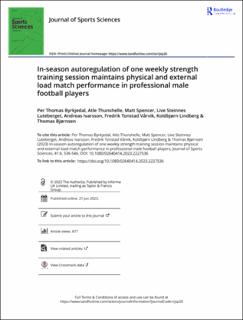| dc.contributor.author | Byrkjedal, Per Thomas | |
| dc.contributor.author | Thunshelle, Atle | |
| dc.contributor.author | Spencer, Matthew | |
| dc.contributor.author | Luteberget, Live Steinnes | |
| dc.contributor.author | Ivarsson, Andreas | |
| dc.contributor.author | Vårvik, Fredrik Tonstad | |
| dc.contributor.author | Lindberg, Kolbjørn Andreas | |
| dc.contributor.author | Bjørnsen, Thomas | |
| dc.date.accessioned | 2023-10-23T11:59:43Z | |
| dc.date.available | 2023-10-23T11:59:43Z | |
| dc.date.created | 2023-07-13T10:26:36Z | |
| dc.date.issued | 2023 | |
| dc.identifier.citation | Journal of Sports Sciences. 2023, 41(6), Side 536-546. | en_US |
| dc.identifier.issn | 0264-0414 | |
| dc.identifier.uri | https://hdl.handle.net/11250/3098086 | |
| dc.description | This is an Open Access article distributed under the terms of the Creative Commons Attribution License (http://creativecommons.org/licenses/by/4.0/), which permits unrestricted use, distribution, and reproduction in any medium, provided the original work is properly cited. The terms on which this article has been published allow the posting of the Accepted Manuscript in a repository by the author(s) or with their consent. | en_US |
| dc.description.abstract | The aim of this study was to compare the effects of autoregulating strength training volume based on an objective (external load match performance) versus a subjective (self-selected) method in professional male football players. Sixteen players completed a 10-week strength training programme where the number of sets was regulated based on football match high-intensity running distance (HIR >19.8 km/h, AUTO, n = 7), or self-selected (SELF, n = 9). In addition to traditional physical performance assessments (30-m sprint, countermovement jump, leg-strength, and body composition), external load match performance was assessed with five matches in the beginning and in the end of the study period. Both groups performed ~ 1 weekly bout of ~ 6 sets in leg extensor exercises during the 10-week period, and maintained physical performance during the competitive season, with no group differences detected after the training period. Non-overlap of all pairs (NAP) analysis showed weak-to-moderate effects in external load match performance from before to after the study period, suggesting that players maintained or improved their performance. In conclusion, no group differences were observed, suggesting that both external load autoregulated and self-selected, low-volume in-season strength training maintained physical, and external load match performance in professional male football players. | en_US |
| dc.language.iso | eng | en_US |
| dc.subject | athlete monitoring | en_US |
| dc.subject | GPS | en_US |
| dc.subject | resistance training | en_US |
| dc.subject | soccer | en_US |
| dc.title | In-season autoregulation of one weekly strength training session maintains physical and external load match performance in professional male football players | en_US |
| dc.type | Peer reviewed | en_US |
| dc.type | Journal article | en_US |
| dc.description.version | publishedVersion | en_US |
| dc.rights.holder | © 2023 The Author(s) | en_US |
| dc.source.pagenumber | 536-546 | en_US |
| dc.source.volume | 41 | en_US |
| dc.source.journal | Journal of Sports Sciences | en_US |
| dc.source.issue | 6 | en_US |
| dc.identifier.doi | 10.1080/02640414.2023.2227536 | |
| dc.identifier.cristin | 2162211 | |
| dc.description.localcode | Institutt for fysisk prestasjonsevne / Department of Physical Performance | en_US |
| cristin.ispublished | true | |
| cristin.fulltext | original | |
| cristin.qualitycode | 2 | |
